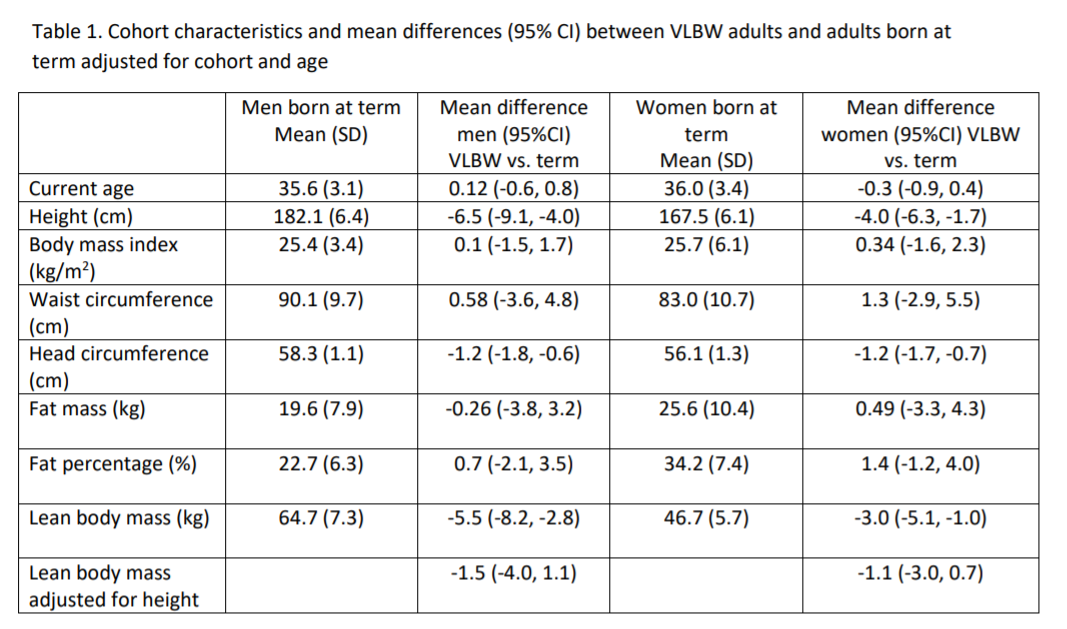Back
Neonatal Follow-up
Category: Abstract Submission
Neonatal Follow-up III
261 - Body composition of adults born preterm at very low birth weight entering middle age: a two-country birth cohort study
Saturday, April 23, 2022
3:30 PM – 6:00 PM US MT
Poster Number: 261
Publication Number: 261.225
Publication Number: 261.225
Laura Jussinniemi, University of Oulu and Finnish Institute for Health and Welfare, Liminka, Pohjois-Pohjanmaa, Finland; Maarit K. Kulmala, FInnish Institute for Health and Welfare, Helsinki University Hospital, Espoo, Uusimaa, Finland; Kristina Anna Djupvik Aakvik, Norwegian University of Science and Technology, Trondheim, Sor-Trondelag, Norway; Silje D. Benum, Norwegian University of Science and Technology, Trondheim, Sor-Trondelag, Norway; Anna Jørgensen, NTNU, Trondheim, Sor-Trondelag, Norway; Kari Anne I. Evensen, Norwegian University of Science and Technology, Trondheim, Sor-Trondelag, Norway; Eero Kajantie, University of Oulu and Finnish Institute for Health and Welfare, Helsinki, Uusimaa, Finland

Laura Jussinniemi, M.Sc, PhD Candidate (she/her/hers)
PhD Candidate, M.Sc
University of Oulu and Finnish Institute for Health and Welfare
Liminka, Pohjois-Pohjanmaa, Finland
Presenting Author(s)
Background: Adults born preterm with very low birth weight (VLBW; < 1500g) are shorter and have increased levels of cardiometabolic risk factors than those born at term. Their body composition has been little studied.
Objective: This longitudinal study of two birth cohorts aim to assess body composition of adults born at VLBW entering middle age. We hypothesized that adults born preterm at VLBW have lower lean body mass and higher fat percentage than those born at term.
Design/Methods: Data was collected from a joint assessment of two longitudinal birth cohorts with harmonized methods, the Helsinki Study of Very Low Birth Weight Adults (HeSVA) and the Norwegian University of Science and Technology (NTNU) Low Birth Weight in a Lifetime Perspective cohort study. At 32-42 years assessment the HeSVA clinical visits were attended by 92 VLBW adults born in 1978-1985 and 90 controls born at term, group-matched for sex, age and birth hospital. At NTNU, 45 participants born with VLBW and 68 term-born controls were assessed, all born in 1986-1988 in the Trondheim region. VLBW adults (46 men, 66 women) were born at 29 weeks (SD 2.4 of gestation weighing on average 1169 g (SD 214). Participants in the control group (61 men, 84 women) were born at 40 weeks (SD 1.2) of gestation, weighing on average 3 660 g (SD 479). Body composition was assessed in 2019-2021 during the clinical visits anthropometrically and by 8-polar bioelectrical impedance analysis (n=257) validated in Nordic populations (Seca® mBCA 515).
Results: Adjusted for age and cohort, VLBW men were 6.5 cm (SD -9.1, -4.0) and women 4.0 cm (SD -6.3, -1.7) shorter and their head circumference was smaller than their peers born at term (Table 1). VLBW adults had lower lean body mass, but this was largely explained by their shorter height. There was no difference in body fat percentage.Conclusion(s): Adults born with very low birth weight entering middle age are shorter and have smaller heads than those born at term. They have a lower lean body mass, which is largely explained by their shorter height. This should bring attention to their risk for future health problems.
Table 1. Cohort characteristics and mean differences (95% CI) between VLBW adults and adults born at term adjusted for cohort and age
Objective: This longitudinal study of two birth cohorts aim to assess body composition of adults born at VLBW entering middle age. We hypothesized that adults born preterm at VLBW have lower lean body mass and higher fat percentage than those born at term.
Design/Methods: Data was collected from a joint assessment of two longitudinal birth cohorts with harmonized methods, the Helsinki Study of Very Low Birth Weight Adults (HeSVA) and the Norwegian University of Science and Technology (NTNU) Low Birth Weight in a Lifetime Perspective cohort study. At 32-42 years assessment the HeSVA clinical visits were attended by 92 VLBW adults born in 1978-1985 and 90 controls born at term, group-matched for sex, age and birth hospital. At NTNU, 45 participants born with VLBW and 68 term-born controls were assessed, all born in 1986-1988 in the Trondheim region. VLBW adults (46 men, 66 women) were born at 29 weeks (SD 2.4 of gestation weighing on average 1169 g (SD 214). Participants in the control group (61 men, 84 women) were born at 40 weeks (SD 1.2) of gestation, weighing on average 3 660 g (SD 479). Body composition was assessed in 2019-2021 during the clinical visits anthropometrically and by 8-polar bioelectrical impedance analysis (n=257) validated in Nordic populations (Seca® mBCA 515).
Results: Adjusted for age and cohort, VLBW men were 6.5 cm (SD -9.1, -4.0) and women 4.0 cm (SD -6.3, -1.7) shorter and their head circumference was smaller than their peers born at term (Table 1). VLBW adults had lower lean body mass, but this was largely explained by their shorter height. There was no difference in body fat percentage.Conclusion(s): Adults born with very low birth weight entering middle age are shorter and have smaller heads than those born at term. They have a lower lean body mass, which is largely explained by their shorter height. This should bring attention to their risk for future health problems.
Table 1. Cohort characteristics and mean differences (95% CI) between VLBW adults and adults born at term adjusted for cohort and age

